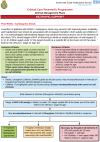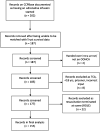Is there an association between 30-day mortality and adrenaline infusion rates in post-ROSC patients? A retrospective observational analysis
- PMID: 36531796
- PMCID: PMC9730193
- DOI: 10.29045/14784726.2022.12.7.3.1
Is there an association between 30-day mortality and adrenaline infusion rates in post-ROSC patients? A retrospective observational analysis
Abstract
Introduction: Revised guidelines for the management of cardiac arrest have placed greater emphasis on early defibrillation and closed chest compressions; subsequently there has been a significant rise in the number of patients gaining a return of spontaneous circulation (ROSC). As a consequence, emergency medical services have realised the importance of therapies delivered during this phase of care. In some Trusts this includes the use of inotropic agents to augment the cardiovascular system and maintain adequate cerebral and coronary perfusion pressures to mitigate the effects of post-cardiac arrest syndrome. Currently, limited evidence exists with regards to the efficacy of such treatments in the pre-hospital phase.
Methods: Retrospective observational analysis of out-of-hospital cardiac arrest patients who received an adrenaline infusion by critical care paramedics. Infusion rates, time of call (ToC) to ROSC and 30-day mortality were compared.
Results: Over a 2-year period, 202 patients were recorded as having an adrenaline infusion commenced. Of these, 25 were excluded as they did not meet criteria or had incomplete data and 22 were excluded as the infusion was stopped at scene; 155 patients were admitted to hospital. There were no survivors in the non-shockable group and three survivors in the shockable group at 30 days. A rare events analysis found no relationship between infusion rate, ToC to ROSC and 30-day mortality (Wald chi2, 1.37).
Conclusion: Commencement of adrenaline infusions in post-ROSC was associated with significant 30-day mortality, especially in non-shockable rhythms. Further research is needed to elucidate whether this intervention has any benefit in the post-ROSC patient.
Keywords: ROSC; adrenaline; infusion; out-of-hospital cardiac arrest; post-cardiac arrest syndrome; vasopressors.
© 2022 The Author(s).
Conflict of interest statement
The primary investigator (PO) works for SECAmb as a CCP.
Figures




Similar articles
-
Adrenaline, ROSC and survival in patients resuscitated from in-hospital cardiac arrest.Resuscitation. 2019 Jul;140:64-71. doi: 10.1016/j.resuscitation.2019.05.004. Epub 2019 May 21. Resuscitation. 2019. PMID: 31125581
-
[Profile and outcome of cardiopulmonary resuscitation after sudden cardiac arrests in the emergency department: a multicenter prospective observational study].Zhonghua Wei Zhong Bing Ji Jiu Yi Xue. 2018 Mar;30(3):234-239. doi: 10.3760/cma.j.issn.2095-4352.2018.03.009. Zhonghua Wei Zhong Bing Ji Jiu Yi Xue. 2018. PMID: 29519282 Chinese.
-
[Influence factors analysis of mechanical compression and hands-only compression on restoration of spontaneous circulation and prognosis in patients with cardiac arrest].Zhonghua Wei Zhong Bing Ji Jiu Yi Xue. 2019 Mar;31(3):303-308. doi: 10.3760/cma.j.issn.2095-4352.2019.03.009. Zhonghua Wei Zhong Bing Ji Jiu Yi Xue. 2019. PMID: 30914090 Chinese.
-
Impact of delayed and infrequent administration of vasopressors on return of spontaneous circulation during out-of-hospital cardiac arrest.Prehosp Emerg Care. 2013 Jan-Mar;17(1):15-22. doi: 10.3109/10903127.2012.702193. Epub 2012 Jul 23. Prehosp Emerg Care. 2013. PMID: 22824006
-
Adrenaline and vasopressin for cardiac arrest.Cochrane Database Syst Rev. 2019 Jan 17;1(1):CD003179. doi: 10.1002/14651858.CD003179.pub2. Cochrane Database Syst Rev. 2019. PMID: 30653257 Free PMC article.
References
-
- Adnet F., Triba M. N., Borron S. W., Lapostolle F., Hubert H., Gueugniaud P. Y., Escutnaire J., Guenin A., Hoogvorst A., Marbeuf-Gueye C. & Reuter P. G. (2017). Cardiopulmonary resuscitation duration and survival in out-of-hospital cardiac arrest patients. Resuscitation, 111, 74–81. - PubMed
-
- Chambers D. J. (2019). Principles of intravenous drug infusion. Anaesthesia and Intensive Care Medicine, 20(1), 61–64.
-
- Cole J. B. (2018). Bolus-dose vasopressors in the emergency department: First, do no harm; second, more evidence is needed. Annals of Emergency Medicine, 71(1), 93–95. - PubMed
-
- De Backer D., Creteur J., Silva E. & Vincent J. L. (2003). Effects of dopamine, norepinephrine, and epinephrine on the splanchnic circulation in septic shock: Which is best? Critical Care Medicine, 31(6), 1659–1667. - PubMed
LinkOut - more resources
Full Text Sources
Research Materials
Miscellaneous
